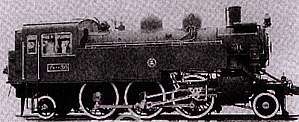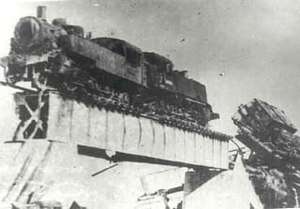Sentetsu Pureha-class locomotives
| Chosen Government Railway Pureha class (プレハ) Korean National Railroad Pureo8 class (푸러8) Korean State Railway Purŏp'a class (부러파) | |||||||||||||||||||||||||||||||||||||||||||||||||||
|---|---|---|---|---|---|---|---|---|---|---|---|---|---|---|---|---|---|---|---|---|---|---|---|---|---|---|---|---|---|---|---|---|---|---|---|---|---|---|---|---|---|---|---|---|---|---|---|---|---|---|---|
 Builder's photo of Sentetsu プレハ36, built by Kisha Seizō in 1939. | |||||||||||||||||||||||||||||||||||||||||||||||||||
| |||||||||||||||||||||||||||||||||||||||||||||||||||
| |||||||||||||||||||||||||||||||||||||||||||||||||||
| |||||||||||||||||||||||||||||||||||||||||||||||||||
| |||||||||||||||||||||||||||||||||||||||||||||||||||
The Pureha-class (プレハ) locomotives were a group of steam tank locomotives with 2-6-2 wheel arrangement of used by the Chosen Government Railway (Sentetsu) in Korea. The "Pure" name came from the American naming system for steam locomotives, under which locomotives with 2-6-2 wheel arrangement were called "Prairie".[1]
In all, Sentetsu owned 227 locomotives of all Pure classes, whilst privately owned railways owned another 52; of these 279 locomotives, 169 went to the Korean National Railroad in South Korea and 110 to the Korean State Railway in North Korea.[2]
Description
The プレハ (Pureha) class was the eighth and final class of 2-6-2 locomotives procured by Sentetsu.[3] They were designed by Sentetsu as the most advanced locomotives in Korea at the time of their introduction, and the first twelve were built in 1932 by the Gyeongsong Works. A further 26 were built in 1939 by Hitachi and Kisha Seizō and assembled at Sentetsu's Busan shops.[4] Unlike previous Pure class locomotives, the Pureha class had larger driving wheels, with a diameter of 1,520 mm (60 in), which increased their maximum speed to 90 km/h (56 mph). They were frequently used for express trains on the Gyeongin Line.[4]
Postwar

After the end of the Pacific War and the subsequent partition of Korea, these locomotives were divided between North and South Korea.
Korean National Railroad 푸러8 (Pureo8) class
Many Pureha class locomotives were used by the Korean National Railroad after Liberation, which designated them 푸러8 (Pureo8) class;[4] they were used by the KNR primarily for shunting duties, and on light local and suburban passenger services.[5]
Korean State Railway 부러파 (Purŏp'a) class/1800 series
The Sentetsu Purena class locomotives that remained in the North after the partition of Korea were operated by the Korean State Railway, designating them 부러파 (Purŏp'a) class, and later renumbering them into the 1800 series around the early 1970s. The total number and identities of the engines that went north is uncertain, but it is known プレハ38 had gone to the north, where it was in use around Hamheung in 1951, still carrying Sentetsu number plates and emblems. It is unknown whether the locomotive remained in the North after the Korean War, or if it was taken by UN forces during the withdrawal.[5]
Construction
| Sentetsu running number | Postwar | |||||
|---|---|---|---|---|---|---|
| 1938–1945 | pre-1938 | Owner | Number | Builder | Year | Notes |
| プレナ1 | プレ351 | KNR | 푸러8-1 | Gyeongseong | 1932 | |
| プレナ2 | プレ352 | ? | ? | Gyeongseong | 1932 | |
| プレナ3 | プレ353 | ? | ? | Gyeongseong | 1932 | |
| プレナ4 | プレ354 | ? | ? | Gyeongseong | 1932 | |
| プレナ5 | プレ355 | ? | ? | Gyeongseong | 1932 | |
| プレナ6 | プレ356 | ? | ? | Gyeongseong | 1932 | |
| プレナ7 | プレ357 | ? | ? | Gyeongseong | 1932 | |
| プレナ8 | プレ358 | ? | ? | Gyeongseong | 1932 | |
| プレナ9 | プレ359 | ? | ? | Gyeongseong | 1932 | |
| プレナ10 | プレ360 | ? | ? | Gyeongseong | 1932 | |
| プレナ11 | プレ361 | ? | ? | Gyeongseong | 1932 | |
| プレナ12 | プレ362 | ? | ? | Gyeongseong | 1932 | |
| プレナ13 | - | KNR | 푸러8-13 | Hitachi | 1939 | Large Latin "KNR" lettering in 1954.[5] |
| プレナ14 | - | KNR | 푸러8-14 | Hitachi | 1939 | |
| プレナ15 | - | KNR | 푸러8-15 | Hitachi | 1939 | Derelict by 1953.[5] |
| プレナ16 | - | ? | ? | Hitachi | 1939 | |
| プレナ17 | - | ? | ? | Hitachi | 1939 | |
| プレナ18 | - | ? | ? | Hitachi | 1939 | |
| プレナ19 | - | KNR | 푸러8-19 | Hitachi | 1939 | In service in 1960. |
| プレナ20 | - | KNR | 푸러8-20 | Hitachi | 1939 | |
| プレナ21 | - | ? | ? | Hitachi | 1939 | |
| プレナ22 | - | KNR | 푸러8-22 | Hitachi | 1939 | |
| プレナ23 | - | ? | ? | Hitachi | 1939 | |
| プレナ24 | - | ? | ? | Hitachi | 1939 | |
| プレナ25 | - | KNR | 푸러8-25 | Hitachi | 1939 | |
| プレナ26 | - | ? | ? | Hitachi | 1939 | |
| プレナ27 | - | ? | ? | Hitachi | 1939 | |
| プレナ28 | - | KNR | 푸러8-28 | Hitachi | 1939 | |
| プレナ29 | - | ? | ? | Hitachi | 1939 | |
| プレナ30 | - | ? | ? | Kisha Seizō | 1939 | |
| プレナ31 | - | ? | ? | Kisha Seizō | 1939 | |
| プレナ32 | - | ? | ? | Kisha Seizō | 1939 | |
| プレナ33 | - | ? | ? | Kisha Seizō | 1939 | |
| プレナ34 | - | ? | ? | Kisha Seizō | 1939 | |
| プレナ35 | - | ? | ? | Kisha Seizō | 1939 | |
| プレナ36 | - | ? | ? | Kisha Seizō | 1939 | |
| プレナ37 | - | ? | ? | Kisha Seizō | 1939 | |
| プレナ38 | - | KSR | 부러파38 | Kisha Seizō | 1939 | Still with Sentetsu number plates in 1951.[5] |
References
- ↑ Colvin, Fred H. (1906). The railroad pocket-book: a quick reference cyclopedia of railroad information. New York, Derry-Collard; London, Locomotive Publishing Company (US-UK co-edition). p. L‑9.
- ↑ "North and South Korea Steam Locomotives". 20 April 2004. Archived from the original on 20 April 2004.
- ↑ "プレーリー型タンク機関車". Archived from the original on 2017-08-26.
- 1 2 3 Byeon, Seong-u (1999). 한국철도차량 100년사 [Korean Railways Rolling Stock Centennial] (in Korean). Seoul: Korea Rolling Stock Technical Corp.
- 1 2 3 4 5 "Korean National RR Class PR-8 2-6-2T". donsdepot.donrossgroup.net.